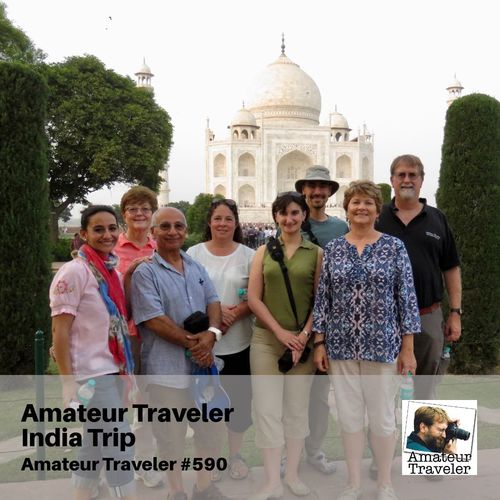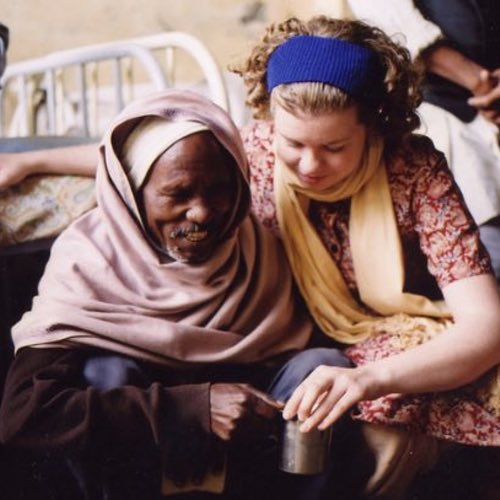We sat in a circle on small plastic stools in the tiny shop enjoying our lassis, a refreshing yogurt-based treat in India. Our conversation was interrupted every few minutes by a procession of mourners heading down to a ghat on the Ganges river with the body of some deceased loved one on their shoulders. The body was covered with a simple shroud. Mourners called out “ram naam satya hai” which means “truth is the name of Lord Rama.” They were taking the body to the river bank to be cremated. Welcome to Varanasi, India.
Varanasi is different. It gets a great deal of tourists like the Taj Mahal at Agra, but it lacks a single stunning architectural wonder. The attraction is the people of India and their Hindu faith. Varanasi is a holy city to Hindus along the bank of the equally holy Ganges river in the northern Indian state of Uttar Pradesh.
Holy Cow
We arrived in Varanasi on a night train from New Delhi, and it was obvious from our initial tuk-tuk ride to our hotel that the visit to Varanasi would be different. We had seen a few cows wandering the streets of New Delhi, but when we did, it was noticeable as they were infrequent. In Varanasi, there were so many, and our tuk-tuk divers would drive so close to them that you really had to keep an eye out lest you run into one as you leaned out of the tuk-tuk to take a picture of the colorful vendors. All of this was done to the constant soundtrack of traffic and the ubiquitous honking of horns.
At least once, members of our group were charged by cows not so much with malice but with indifference to our presence. In a country where even McDonald’s doesn’t serve beef, they get pretty confident, and we had to scramble out of the way as they quickly descended the stairs along the shore of the Ganges.
The Ganges
We took a pedicab from our hotel, which was outside the hubbub of downtown Varanasi. The pedicabs, motorcycles, and tuk-tuks jostled their way uncertainly but inevitably towards the Ganges River.
Along the Ganges at Varanasi are a series of 88 different places called ghats which have steps going down into the river. At most of these, you can find people ceremonially washing.
At a couple of them (Manikarnika ghat and Harishchandra ghat), you can find bodies being cremated and then scattered on the waters of the Ganges. This is done in the belief this will help the loved one achieve moksha, the end of the cycle of reincarnation. Why would you want to do this? Because, as I understand it, Hindus believe that life is struggle. Moksha translates as liberation.
Sunrise
The various ghats are a place of worship (or puja) all day long, but this is punctuated with special ceremonies at sunrise and sunset. At sunrise, we visited a ghat where 7 young priests (always an odd number) were chanting behind 7 different braziers filled with incense. It is an ancient ceremony. The chanting sounded repetitive to my western ears. We stood a bit apart with the other curious tourists.
- Get a universal plug adapter
- Buy Travel Insurance
- Get an eSim to be able to use your smartphone abroad.
- Search for Great Tours HERE
- Book Your Accommodation HERE
- Get a Car Rental

Sunrise Boat Trip
One of the highlights of our visit was boarding a small wooden boat for a tour along the river as the city appeared out of the mist and smoke of its morning reverie. Along the side of the river, we passed the different ghats with holy men and ordinary men and women bathing. Hindus believe that the water of the Ganges is pure and that bathing washes away sins and helps to achieve moksha. While the water may be spiritually pure, we did see at least one carcass of a dead goat, and it is not unheard of to see bodies of those who can’t afford cremation floating down the river.
The sun slowly forced its way through the mist and smoke which shroud the river. I burned through one battery on my camera and threatened to fill up my camera’s memory card with photos of the colorful boats and the misty ethereal shore.
Everywhere on shore, there were the colorful Indian women and their monochrome husbands and sons.
Here and there, a multicolor holy man stood out as a stark contrast.
We passed a flotilla of other boats like ours filled with tourists.
We passed numerous temples, including Ratneshwar Mahadev, which is known as the leaning temple. There are multiple legends associated with the temple, but the one our guide told us was that it was built by a king named Man Singh to repay his mother for all she had done for him, but, as everyone knows, it is impossible to pay the debt that is owed to your mother, so the temple was cursed by his mother.
We passed the large piles of wood topped with a body that slowly turned to ash. Here we put away our cameras as it is inappropriate to film what is a very personal and, to the Hindus, a very sacred process.
We passed two different Bollywood movie casts filming a musical dance scene.
Exploring
During the day, we explored the various ghats and back alleys of Varanasi. We shopped for spices and clothes. There are bargains to be had in these small side streets. We watched a local girl feed a monkey at her window.
As I mentioned, we stopped for lassies at Blue Lassi. The lassis are served in a biodegradable bowl which is just left in the street and breaks down to dirt. Granted, it is an odd if seminal experience to be enjoying a delicious lassi while witnessing public mourning.
What they don’t mention about the sacred cows is that they leave cow pies just like secular ones. We had to keep a sharp eye as we walked around town to avoid the “holy crap”.
Ramnagar Fort
We crossed the Ganges and toured the Ramnagar Fort. Photos were not allowed inside the fort, but sadly they would have shown a fort in disrepair, with museum exhibits covered in dust. It could be a significant tourist spot but may not be worth the effort to visit at this time.
Sunset Boat Ride
We boarded a boat again at sunset. We paused on our journey down the river to light small candles and set them adrift on the river with our prayers. The candle boats, like the lassi bowls are biodegradable.
At a few of the larger ghats, there is a colorful, noisy, smokey, fire-filled evening ceremony. Again there are always an odd number of priests twirling fire and chanting.
While this is happening onshore, there is a flotilla of boats full of tourists clustered gunnel to gunnel in the river, with young chi vendors selling their wares as they hop from one boat to another.
Varanasi is an old city dating back to at least 1800 B.C. Varanasi is spectacle and devotion, delicious and challenging, unpolished, and captivating. Varanasi is India.
I was in Varanasi as part of a larger trip from Intrepid Travel called Indian Getaway which also included Deli, Agra, Jaipur, and a village visit.
Podcast
For more about this trip listen to Travel to India – Amateur Traveler Episode 590


Hear more about our trip in Amateur Traveler India Trip – Amateur Traveler Episode 590 or check out all my photos from Varanasi.
+Chris Christensen | @chris2x | facebook
5 Responses to “Varanasi, India – Ceremony, Tourism and Death on the Ganges (Video #103)”
Leave a Reply
Tags: article, best, featured, india, intrepid travel, varanasi, video travel podcast


























 Travel to India – Episode 590
Travel to India – Episode 590 Intrepid Travel India – Review: “Indian Getaway” tour
Intrepid Travel India – Review: “Indian Getaway” tour Volunteering in India – Sustainable Tourism
Volunteering in India – Sustainable Tourism Roopkund Trek: My Himalayan Death Trek – India
Roopkund Trek: My Himalayan Death Trek – India

Danica Watson
Says:February 21st, 2019 at 3:38 am
Thanks for sharing this amazing post.
Ju Mishra
Says:July 23rd, 2019 at 10:28 pm
Namaste,
Awesome blog over Varanasi, even I m from India. I hope you enjoyed your trip there!!!!
Chris Christensen
Says:July 24th, 2019 at 7:41 am
very much so
Marchus Shane
Says:February 24th, 2020 at 10:20 pm
It was an amazing trip to India during my summer holidays. But I was only there in Delhi because of the limited time I have in India. Love the way you have to explore Varanasi. It makes me feel again backpack to visit Varanasi on my next visit to India. Love the way you have to explore there !!!!
Fiona Manonn
Says:November 10th, 2021 at 12:09 am
Awesome place and blog over Varanasi..I just want to visit there.